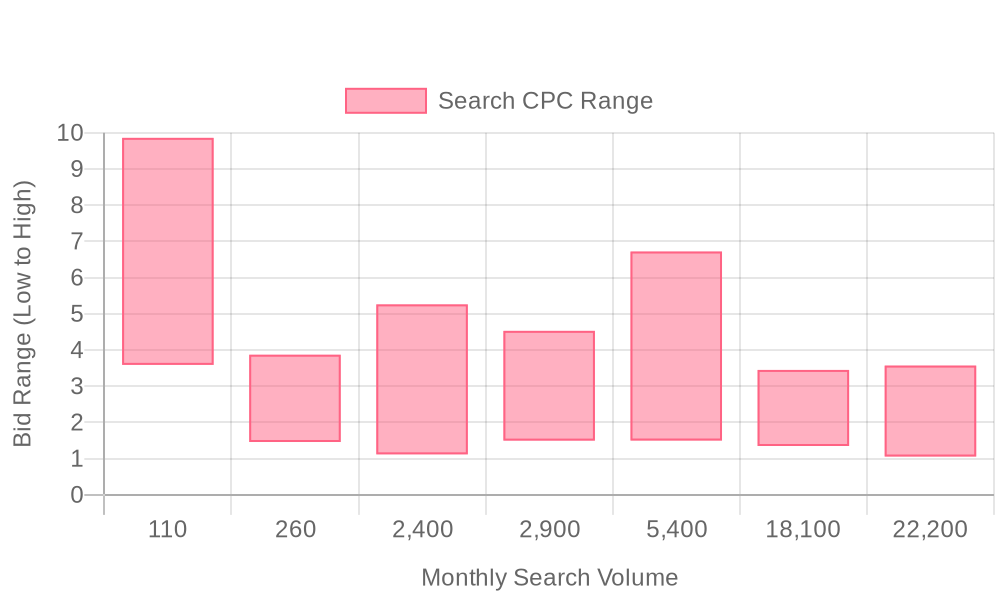
Supercharge your lead generation with a FREE Google Ads audit - no strings attached! See how you can generate more and higher quality leads
Get My Free Google Ads AuditFree consultation

No commitment
Supercharge your lead generation with a FREE LinkedIn Ads audit - no strings attached! See how you can generate more and higher quality leads
Get My Free Google Ads AuditFree consultation

No commitment
Supercharge your lead generation with a FREE Meta Ads audit - no strings attached! See how you can generate more and higher quality leads
Get My Free Google Ads AuditGet My Free LinkedIn Ads AuditGet My Free Meta Ads AuditFree consultation

No commitment
Supercharge your lead generation with a FREE Google Ads audit - no strings attached! See how you can generate more and higher quality leads
Get My Free Google Ads AuditFree consultation

No commitment
In today's complex marketing landscape, effective advertising requires a strategic mix of both online and offline channels. Google Ads plays a critical role for Therapy Dog Services by capturing high-intent prospects exactly when they are searching for solutions, effectively bridging the gap between broader awareness efforts and your service offerings. Utilizing online advertising magnifies your reach and boosts client acquisition with precision targeting, measurable outcomes, and enhanced visibility. For Therapy Dog Services, Google Ads represents a powerful opportunity to connect with potential clients precisely at their moment of need and to enhance visibility amongst competitive offerings. This comprehensive guide will delve into strategic approaches and best practices to leverage Google Ads effectively for your therapy dog business.

Therapy dog service providers are seeing a surge in demand from healthcare, education, and community partners seeking animal-assisted programs that deliver measurable outcomes. Digital marketing leaders in this sector must employ a tactical, data-driven approach to reach high-intent buyers, capture qualified leads, and nurture relationships with decision-makers who often have complex requirements. Explore actionable strategies and industry trends for the therapy dog training sector in this business ideas guide.
Google Ads for Therapy Dog Services enables operators to harness search intent at the moment of need, connecting with administrators and families who are actively seeking certified therapy teams, training, or support programs. The key to outperforming traditional outreach is leveraging intent signals and automating timely ad delivery, ensuring no opportunity is missed due to delayed follow-up or generic messaging.
This framework positions therapy dog service providers to capitalize on digital demand, deliver actionable insights to their teams, and capture more of the right leads at every stage of the buyer journey. Ready to accelerate your lead generation? Get started for free with Sona.

Therapy dog services operate in a highly specialized, regulated market with a fragmented digital footprint. Capturing qualified demand relies on reaching people and organizations actively searching for emotional support solutions, which means every click must deliver measurable intent and value. Google Ads for dog training offers strategies to directly target and engage these specific audiences.
Google Ads provides direct access to engaged audiences, from hospital administrators to families seeking certified therapy dogs. With advanced audience segmentation and intent-based targeting, therapy dog providers gain the ability to distinguish between exploratory traffic and high-value prospects, optimizing campaign spend for the most lucrative leads.
Want to see how seamless marketing measurement and optimization can be? Get started for free with Sona.

To see how these campaign types can be tailored to your therapy dog business, get started for free with Sona.

Growth in therapy dog service marketing depends on unlocking untapped demand that typical channels miss. A focused approach, rooted in data and vertical specialization, helps teams reach decision-makers and caregivers already searching for therapy dog solutions but not yet in your network. For guidance on maximizing marketing analytics and identifying new opportunities, explore the Sona blog.
This approach to Google Ads for therapy dogs transforms growth from guesswork into a measurable, scalable process. By systematically identifying where competitors lag, aligning messaging with specific intent, and nurturing leads through continuous audience refinement, therapy dog service providers can secure a sustainable pipeline of high-value opportunities. Ready to capture more qualified leads? Get started for free with Sona.
Precise audience segmentation transforms campaign performance for therapy dog services by aligning messaging, creative, and spend with the nuanced needs of each target group. By leveraging real-time audience segmentation, providers ensure ad delivery is relevant, budget is efficiently allocated, and every impression has the highest potential for measurable engagement.

| Industry | Keyword | Monthly Search Volume | Competition Level | Low Bid | High Bid |
| Therapy Dog Services | get my dog certified as a service animal | 110 | HIGH | 3.59 | 9.86 |
| Therapy Dog Services | therapy dog services | 260 | LOW | 1.46 | 3.87 |
| Therapy Dog Services | therapy dogs near me | 2400 | LOW | 1.12 | 5.26 |
| Therapy Dog Services | support dogs | 2900 | MEDIUM | 1.5 | 4.53 |
| Therapy Dog Services | therapy pet | 5400 | LOW | 1.5 | 6.72 |
| Therapy Dog Services | therapy dog | 18100 | LOW | 1.35 | 3.45 |
| Therapy Dog Services | service dog trainers near me | 22200 | MEDIUM | 1.06 | 3.57 |
For therapy dog service providers, keyword strategy is central to aligning Google Ads with business objectives. The right keyword mix ensures campaigns intercept prospects at the exact moment they express intent, whether searching for certified therapy dog visits, training, or emotional support programs. By focusing on well-researched, high-intent search terms, marketers can connect directly with healthcare administrators, educational coordinators, or families who are actively seeking specialized therapy dog offerings. For a deeper dive into therapy dog training trends and business ideas, review this therapy dog training industry guide for 2024.
A strong keyword plan for Google Ads for Therapy Dog Services begins with identifying core value propositions and matching them to the language your audience actually uses. This includes both broad and long-tail keywords that reflect the specificity of therapy dog services, such as “therapy dog certification for schools,” “hospital therapy dog program,” or “therapy dog visits for seniors.” Incorporating negative keywords such as “dog walking” or “service dog registration,” further refines targeting and prevents wasted budget on irrelevant queries.
As therapy dog service buyers often have nuanced requirements, effective keyword mapping should be informed by ongoing search term analysis and behavioral data. Marketers leveraging unified data can identify not just which keywords drive clicks, but which convert into qualified leads or facility contracts. When campaign data flows seamlessly from ad platforms into your CRM and marketing systems, it’s possible to adjust bidding and audience logic in real time, focusing spend on the most promising segments and keywords.
Dynamic keyword strategies keep campaigns agile. As audiences move through the decision journey—exploring options, requesting information, or scheduling a visit—your keyword lists should evolve. Automated workflows can update negative keywords, add localized modifiers, and prioritize intent-driven search terms as new market signals emerge. This ensures Google Ads for therapy dog services delivers not just traffic, but measurable business outcomes. If you’re ready to optimize your therapy dog service campaigns, get started for free with Sona.
Modern therapy dog service providers require a focused, data-driven approach to digital advertising. Success hinges on precise targeting, compelling messaging, and an ecosystem that connects ad engagement to real business results. When campaigns are built upon unified data and real-time intent, teams can reach high-value decision makers and families at the moment they seek support.
Google Ads for Therapy Dog Services empowers marketers to capture both institutional and individual demand. By structuring campaigns around the unique journey of therapy dog clients, businesses can increase ROI, accelerate lead qualification, and ensure continuity between online discovery and offline service delivery.
Sona equips marketers with granular keyword insights derived from unified intent signals and historical engagement data. This allows teams to prioritize high-converting terms, continuously refine negative keyword lists, and react instantly to shifts in search behavior for therapy dog advertising.
When ad creative is informed by real-time visitor intent and segmented audience data, businesses can dynamically align messaging with what matters most to each cohort. Sona’s approach ensures that ad copy not only resonates but also adapts as leads progress—maximizing both engagement and conversion for therapy dog service marketing.
Sona's visitor identification capabilities connect ad clicks with CRM records, enabling marketers to personalize landing experiences for known accounts. This tight integration ensures that every user, whether a school administrator or a parent, encounters messaging and offers tailored to their segment, improving lead quality and accelerating sales cycles.
Through Sona’s advanced attribution and CRM sync, marketers gain true visibility into the full buyer journey—including both online and offline conversions. This enables therapy dog service providers to make every optimization decision based on actual revenue impact, unify their sales and marketing workflows, and drive ongoing improvements in campaign effectiveness and efficiency. If you’re ready to put these strategies into practice, get started for free with Sona.

Expanding your therapy dog services requires more than increased ad spend: it demands cohesive messaging, smart audience segmentation, and continuous adaptation to audience needs. Success hinges on integrating insights across touchpoints and ensuring every campaign is fueled by actionable data.
Implementing effective Google Ads for therapy dog services hinges on this iterative, data-driven approach. By sharpening your targeting, integrating CRM intelligence, and adapting content to regional and industry shifts, every campaign becomes smarter, more personalized, and ultimately, more profitable. Ready to optimize your therapy dog marketing? Get started for free with Sona.
Harnessing the power of Google Ads can transform the way you market your therapy dog services, opening doors to increased visibility and client engagement. By leveraging strategic advertising techniques, you can effectively reach those in need of your services, ensuring your therapy dogs can make a meaningful impact in the lives of many.
Throughout this guide, we've delved into the intricacies of setting up successful Google Ads campaigns for therapy dog services. From identifying your target audience to crafting compelling ad copy and optimizing your budget, each aspect plays a crucial role in maximizing your advertising efforts and ensuring a strong return on investment.
As you embark on this journey, remember that the right strategy can significantly amplify your reach and impact. Take the insights and strategies discussed here to refine your approach, and watch as your therapy dog services become more accessible to those who benefit most from them.
Ready to elevate your marketing efforts? Start for free to experience our platform's capabilities today and see firsthand how it can unify your go-to-market data for actionable insights.
The best strategies include implementing a data-driven paid search strategy, utilizing therapy-specific keyword and audience targeting, aligning landing pages and creatives for maximum conversion, optimizing performance with segmented messaging, and integrating cross-channel strategies for cohesive outreach.
Set up Google Ads by building targeted keyword lists, developing compelling ad copy, designing effective landing pages, and implementing data-driven optimizations such as tracking conversions and using Smart Bidding strategies.
Use core service keywords like 'therapy dog services,' training and certification keywords such as 'therapy dog certification,' condition-specific keywords like 'therapy dogs for autism,' and local modifiers such as 'therapy dog service in [city].'
Optimize your ads by monitoring conversions, utilizing Smart Bidding, testing ad copy and landing pages, and using Google Ads data to inform content strategies across all marketing channels.
Allocate budget dynamically by identifying which search queries generate the most qualified leads and shifting spend toward the highest-converting audiences based on real-time bidding adjustments and audience engagement data.
Join results-focused teams combining Sona Platform automation with advanced Google Ads strategies to scale lead generation

Connect your existing CRM

Free Account Enrichment

No setup fees
No commitment required

Free consultation

Get a custom Google Ads roadmap for your business
Join results-focused teams combining Sona Platform automation with advanced Meta Ads strategies to scale lead generation

Connect your existing CRM

Free Account Enrichment

No setup fees
No commitment required

Free consultation

Get a custom Google Ads roadmap for your business
Join results-focused teams combining Sona Platform automation with advanced LinkedIn Ads strategies to scale lead generation

Connect your existing CRM

Free Account Enrichment

No setup fees
No commitment required

Free consultation

Get a custom Google Ads roadmap for your business
Join results-focused teams using Sona Platform automation to activate unified sales and marketing data, maximize ROI on marketing investments, and drive measurable growth

Connect your existing CRM

Free Account Enrichment

No setup fees
No commitment required

Free consultation

Get a custom Google Ads roadmap for your business
Over 500+ auto detailing businesses trust our platform to grow their revenue
Join results-focused teams using Sona Platform automation to activate unified sales and marketing data, maximize ROI on marketing investments, and drive measurable growth

Connect your existing CRM

Free Account Enrichment

No setup fees
No commitment required

Free consultation

Get a custom Google Ads roadmap for your business
Over 500+ auto detailing businesses trust our platform to grow their revenue
Join results-focused teams using Sona Platform automation to activate unified sales and marketing data, maximize ROI on marketing investments, and drive measurable growth

Connect your existing CRM

Free Account Enrichment

No setup fees
No commitment required

Free consultation

Get a custom Google Ads roadmap for your business
Over 500+ auto detailing businesses trust our platform to grow their revenue
Our team of experts can implement your Google Ads campaigns, then show you how Sona helps you manage exceptional campaign performance and sales.
Schedule your FREE 15-minute strategy sessionOur team of experts can implement your Meta Ads campaigns, then show you how Sona helps you manage exceptional campaign performance and sales.
Schedule your FREE 15-minute strategy sessionOur team of experts can implement your LinkedIn Ads campaigns, then show you how Sona helps you manage exceptional campaign performance and sales.
Schedule your FREE 15-minute strategy sessionOur team of experts can help improve your demand generation strategy, and can show you how advanced attribution and data activation can help you realize more opportunities and improve sales performance.
Schedule your FREE 30-minute strategy sessionOur team of experts can help improve your demand generation strategy, and can show you how advanced attribution and data activation can help you realize more opportunities and improve sales performance.
Schedule your FREE 30-minute strategy sessionOur team of experts can help improve your demand generation strategy, and can show you how advanced attribution and data activation can help you realize more opportunities and improve sales performance.
Schedule your FREE 30-minute strategy sessionOur team of experts can help improve your demand generation strategy, and can show you how advanced attribution and data activation can help you realize more opportunities and improve sales performance.
Schedule your FREE 30-minute strategy session





Launch campaigns that generate qualified leads in 30 days or less.
